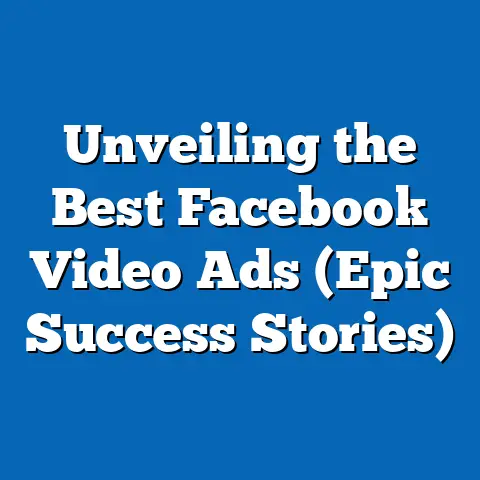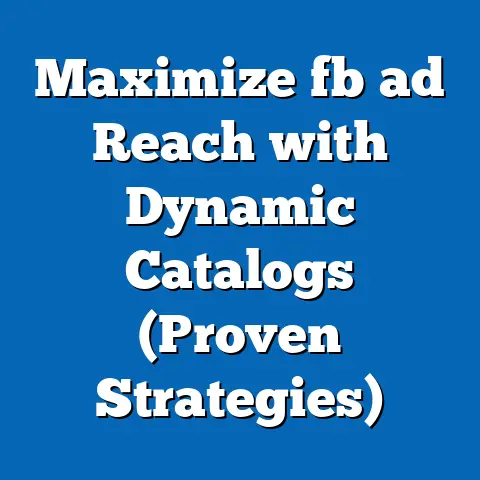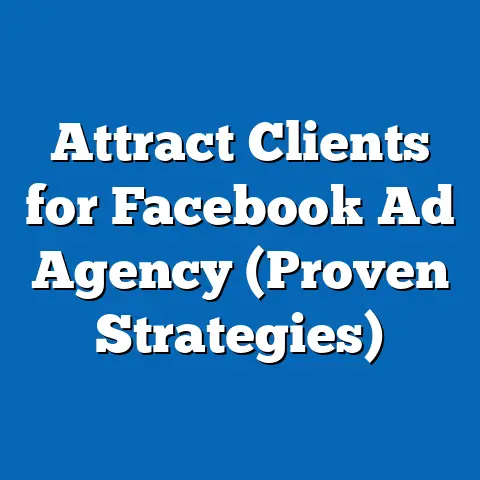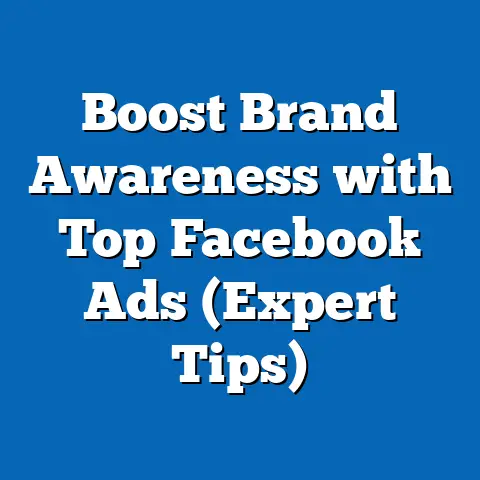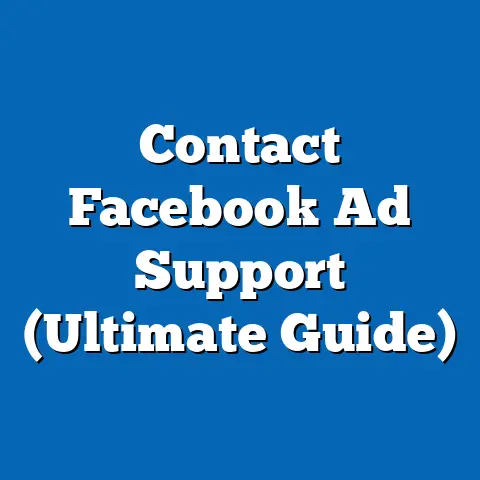Unlocking Competitor fb ad Insights (Strategic Analysis)
In today’s fast-paced world, prioritizing our health and well-being has never been more critical. And as businesses in the health and wellness industry strive to reach their target audiences, Facebook advertising has become an indispensable tool. But here’s the thing: it’s not enough to simply create ads and hope for the best. To truly succeed, you need to understand what your competitors are doing and learn from their successes and failures. Just as athletes analyze their opponents’ strategies to gain a competitive edge, marketers must delve into competitor Facebook ad performance to enhance their own advertising strategies. Think of it as a health check for your marketing – you need to understand the vital signs to improve overall performance.
I’ve seen firsthand how analyzing competitor ads can be a game-changer. In my early days of running Facebook ads for a local yoga studio, I was struggling to get traction. My ads were visually appealing and offered great deals, but they just weren’t converting. It wasn’t until I started meticulously studying the ads of other yoga studios in the area that I realized I was missing a crucial element: emotional connection. Their ads focused on the feeling of community, the stress relief, and the overall sense of well-being that yoga provides. I revamped my strategy to highlight these aspects, and within weeks, I saw a significant increase in sign-ups. This experience taught me the invaluable lesson that understanding your competitors is not about copying them, but about learning from them and finding ways to differentiate yourself.
The Importance of Competitive Analysis in Facebook Advertising
Competitive analysis in Facebook advertising is the process of systematically examining the ad strategies of your competitors to identify their strengths, weaknesses, and overall approach. It’s like having a peek behind the curtain to see what’s working for them and what’s not. This analysis goes beyond simply looking at the ads themselves; it involves understanding their targeting, messaging, creative elements, and overall campaign strategy.
For businesses in the health niche, competitive analysis is particularly crucial for several reasons:
- Understanding the Audience: The health and wellness market is incredibly diverse, with various segments interested in different aspects, from fitness and nutrition to mental health and preventative care. By analyzing your competitors’ ads, you can gain insights into which segments they’re targeting and how they’re tailoring their messaging to resonate with those specific groups.
- Identifying Trends: The health and wellness industry is constantly evolving, with new trends and products emerging all the time. Competitive analysis can help you stay ahead of the curve by identifying which trends your competitors are capitalizing on and how they’re positioning themselves in the market.
- Optimizing Messaging: Crafting effective messaging in the health niche requires a delicate balance of providing accurate information, addressing consumer concerns, and inspiring action. By studying your competitors’ ad copy, you can learn how they’re framing their offers, what language they’re using, and what pain points they’re addressing.
- Improving Creative: Visuals play a significant role in Facebook advertising, and in the health niche, they can be particularly impactful. Analyzing your competitors’ ad creatives can give you ideas for imagery, video content, and design elements that resonate with your target audience.
- Avoiding Mistakes: Competitive analysis can also help you avoid making costly mistakes by identifying what strategies are not working for your competitors. This can save you time, money, and frustration in the long run.
Case Study: Local Gym vs. National Fitness Chain
I once consulted with a local gym that was struggling to compete with a national fitness chain that had recently opened nearby. The local gym had been running Facebook ads for years, but their results had plateaued. After conducting a thorough competitive analysis, we discovered that the national chain was heavily targeting younger demographics with ads that emphasized trendy fitness classes and social media-worthy workout experiences. In contrast, the local gym’s ads were primarily focused on traditional weightlifting and cardio, which appealed more to an older demographic.
Based on these insights, we recommended that the local gym diversify its offerings to include more trendy fitness classes and update its Facebook ads to reflect these changes. We also suggested that they target a younger demographic with ads that emphasized the social aspects of their gym and the unique community it offered. Within a few months, the local gym saw a significant increase in new members and a resurgence in their Facebook ad performance.
Key Takeaway: Competitive analysis isn’t about blindly copying your competitors. It’s about understanding their strategies, identifying their strengths and weaknesses, and using that information to refine your own approach and find ways to differentiate yourself.
Tools and Techniques for Analyzing Competitor Facebook Ads
Fortunately, there are several powerful tools and techniques available to help you analyze your competitor’s Facebook ads. Here are a few of my favorites:
- Facebook Ad Library: This is Facebook’s own tool for transparency, and it’s an invaluable resource for competitive analysis. The Ad Library allows you to search for ads running on Facebook and Instagram by keyword, page name, or topic. You can see the ad creative, ad copy, targeting information (age, gender, location), and the date the ad was first published.
- SEMrush: While primarily known as an SEO tool, SEMrush also offers robust competitive analysis features for Facebook advertising. You can use SEMrush to identify your competitors, analyze their ad budgets, track their ad positions, and see which keywords they’re targeting.
- Adespresso: AdEspresso is a Facebook ad management platform that also includes competitive analysis features. It allows you to track your competitors’ ads, analyze their landing pages, and see which ad creatives are performing best.
- SpyFu: SpyFu is another popular competitive intelligence tool that can be used to analyze Facebook ads. It allows you to see your competitors’ ad spend, track their ad positions, and identify their top-performing ads.
A Step-by-Step Guide to Using the Facebook Ad Library
The Facebook Ad Library is an excellent starting point for your competitive analysis. Here’s how to use it effectively:
- Go to the Facebook Ad Library: Simply search “Facebook Ad Library” on Google, or go directly to https://www.facebook.com/ads/library.
- Select Your Location: Choose the country you’re interested in analyzing. This is important because ad targeting and messaging can vary significantly by location.
- Enter a Keyword or Page Name: In the search bar, enter a keyword related to your niche (e.g., “yoga,” “nutrition,” “weight loss”) or the name of a specific competitor.
- Browse the Results: The Ad Library will display all the active and inactive ads that match your search criteria.
- Filter and Sort: You can filter the results by ad category (e.g., “All Ads,” “Issues, Elections & Politics”) and sort them by date published.
- Analyze the Ads: Click on an ad to see more details, including the ad creative, ad copy, targeting information, and the date the ad was first published.
- Take Notes: As you browse the ads, take notes on the elements that stand out to you, such as the headlines, visuals, calls to action, and overall messaging.
Qualitative vs. Quantitative Metrics
When analyzing competitor Facebook ads, it’s important to consider both qualitative and quantitative metrics.
- Qualitative Metrics: These are subjective observations about the ad, such as the quality of the ad creative, the clarity of the ad copy, and the overall appeal of the messaging.
- Quantitative Metrics: These are objective measurements of the ad’s performance, such as the engagement rate (likes, comments, shares), the click-through rate (CTR), the cost per click (CPC), and the conversion rate.
Interpreting the Data
Once you’ve gathered data on your competitors’ ads, it’s time to interpret the findings. Here are a few key indicators to focus on:
- Ad Spend: How much are your competitors spending on Facebook ads? This can give you an idea of how seriously they’re investing in the platform and how important it is to their overall marketing strategy.
- Targeting: Who are your competitors targeting with their ads? Are they focusing on specific demographics, interests, or behaviors? This can help you identify potential audience segments that you may be missing.
- Messaging: What messages are your competitors using to resonate with their target audience? Are they focusing on benefits, features, or pain points? This can help you refine your own messaging and find ways to differentiate yourself.
- Creative: What types of visuals are your competitors using in their ads? Are they using photos, videos, or graphics? This can give you ideas for improving your own ad creatives.
- Engagement: How are people interacting with your competitors’ ads? Are they liking, commenting, and sharing them? This can give you an idea of how engaging their ads are and what elements are resonating with their audience.
Key Takeaway: Analyzing competitor Facebook ads is not just about collecting data; it’s about interpreting that data and using it to make informed decisions about your own advertising strategy.
Identifying Successful Ad Elements
Now that you know how to find and analyze competitor Facebook ads, let’s dive into the specific elements that make an ad successful. These elements include headlines, visuals, ad copy, and calls to action.
- Headlines: The headline is the first thing people see when they encounter your ad, so it needs to be attention-grabbing and relevant. A good headline should clearly communicate the value proposition of your offer and entice people to click on the ad.
- Visuals: Visuals are just as important as headlines in capturing people’s attention. In the health niche, visuals can be particularly impactful, as they can evoke emotions, inspire action, and showcase the benefits of your products or services.
- Ad Copy: The ad copy is where you can provide more details about your offer and persuade people to take action. A good ad copy should be clear, concise, and compelling, highlighting the benefits of your offer and addressing any potential concerns.
- Calls to Action: The call to action (CTA) is the final element of your ad, and it tells people what you want them to do next. A good CTA should be clear, concise, and action-oriented, such as “Learn More,” “Sign Up Now,” or “Get Started.”
Analyzing Successful Ads in the Health Niche
Let’s take a look at some successful ads from competitors in the health niche and analyze what makes them stand out.
-
Example 1: Meditation App
- Headline: “Find Your Inner Peace with Guided Meditation”
- Visual: A serene image of a person meditating in nature.
- Ad Copy: “Reduce stress, improve focus, and sleep better with our guided meditation app. Download now for a free trial.”
- Call to Action: “Download Now”
- Analysis: This ad is effective because it targets a specific pain point (stress) and offers a clear solution (guided meditation). The visual is calming and inviting, and the ad copy highlights the benefits of the app in a concise and compelling way. The call to action is direct and encourages immediate action.
-
Example 2: Nutrition Coaching Program
-
Headline: “Transform Your Body with Personalized Nutrition Coaching”
- Visual: A before-and-after photo of a client who has successfully transformed their body with the program.
- Ad Copy: “Our nutrition coaching program provides personalized guidance and support to help you achieve your health and fitness goals. Get a free consultation today.”
- Call to Action: “Get a Free Consultation”
- Analysis: This ad is effective because it uses social proof (the before-and-after photo) to demonstrate the effectiveness of the program. The ad copy highlights the personalized approach and the benefits of the program, and the call to action encourages people to take the first step by scheduling a free consultation.
-
Example 3: Yoga Studio
-
Headline: “Find Your Community at Our Local Yoga Studio”
- Visual: A photo of a group of people smiling and laughing after a yoga class.
- Ad Copy: “Our yoga studio offers a welcoming and supportive environment where you can connect with like-minded people and improve your health and well-being. Sign up for a free class today.”
- Call to Action: “Sign Up for a Free Class”
- Analysis: This ad is effective because it focuses on the emotional benefits of yoga, such as community and connection. The visual is warm and inviting, and the ad copy highlights the welcoming environment of the studio. The call to action encourages people to try a free class and experience the community for themselves.
Example 1: Meditation App
- Headline: “Find Your Inner Peace with Guided Meditation”
- Visual: A serene image of a person meditating in nature.
- Ad Copy: “Reduce stress, improve focus, and sleep better with our guided meditation app. Download now for a free trial.”
- Call to Action: “Download Now”
- Analysis: This ad is effective because it targets a specific pain point (stress) and offers a clear solution (guided meditation). The visual is calming and inviting, and the ad copy highlights the benefits of the app in a concise and compelling way. The call to action is direct and encourages immediate action.
-
Example 2: Nutrition Coaching Program
-
Headline: “Transform Your Body with Personalized Nutrition Coaching”
- Visual: A before-and-after photo of a client who has successfully transformed their body with the program.
- Ad Copy: “Our nutrition coaching program provides personalized guidance and support to help you achieve your health and fitness goals. Get a free consultation today.”
- Call to Action: “Get a Free Consultation”
- Analysis: This ad is effective because it uses social proof (the before-and-after photo) to demonstrate the effectiveness of the program. The ad copy highlights the personalized approach and the benefits of the program, and the call to action encourages people to take the first step by scheduling a free consultation.
-
Example 3: Yoga Studio
-
Headline: “Find Your Community at Our Local Yoga Studio”
- Visual: A photo of a group of people smiling and laughing after a yoga class.
- Ad Copy: “Our yoga studio offers a welcoming and supportive environment where you can connect with like-minded people and improve your health and well-being. Sign up for a free class today.”
- Call to Action: “Sign Up for a Free Class”
- Analysis: This ad is effective because it focuses on the emotional benefits of yoga, such as community and connection. The visual is warm and inviting, and the ad copy highlights the welcoming environment of the studio. The call to action encourages people to try a free class and experience the community for themselves.
Example 2: Nutrition Coaching Program
Headline: “Transform Your Body with Personalized Nutrition Coaching”
Example 3: Yoga Studio
Headline: “Find Your Community at Our Local Yoga Studio”
The Importance of Emotional Appeal and Storytelling
In the health niche, emotional appeal and storytelling can be incredibly powerful tools for connecting with your target audience. People are more likely to respond to ads that resonate with their emotions and tell a compelling story.
For example, you could share a story about a client who overcame a health challenge with the help of your product or service. You could also use emotional imagery and language to evoke feelings of hope, inspiration, and empowerment.
Key Takeaway: Successful Facebook ads in the health niche combine attention-grabbing headlines, compelling visuals, clear ad copy, and action-oriented calls to action. They also leverage emotional appeal and storytelling to connect with the target audience on a deeper level.
Strategic Application of Competitor Insights
Now that you have a wealth of insights from analyzing your competitor’s Facebook ads, it’s time to put those insights into action. Here’s how to strategically apply competitor insights to your own Facebook advertising strategy:
- Identify Opportunities: Based on your analysis, identify areas where you can differentiate yourself from your competitors. This could be in your targeting, messaging, creative, or overall approach.
- Refine Your Targeting: Use the insights you’ve gathered about your competitors’ targeting to refine your own targeting strategy. Consider targeting different demographics, interests, or behaviors that your competitors may be overlooking.
- Improve Your Messaging: Use the insights you’ve gathered about your competitors’ messaging to improve your own ad copy and headlines. Focus on highlighting the unique benefits of your product or service and addressing any potential concerns.
- Enhance Your Creative: Use the insights you’ve gathered about your competitors’ creative to enhance your own ad visuals. Experiment with different types of imagery, video content, and design elements to see what resonates best with your target audience.
- Test and Optimize: Once you’ve implemented these changes, it’s important to test and optimize your ads to ensure they’re performing as well as possible. Use A/B testing to compare different headlines, visuals, and ad copy, and track your results to see what’s working best.
- Continuously Monitor: The Facebook advertising landscape is constantly evolving, so it’s important to continuously monitor your competitors’ ads and adapt your strategy accordingly.
Developing a Competitive Ad Strategy
Here’s a framework for developing a competitive ad strategy based on insights gathered:
- Define Your Unique Value Proposition: What makes your product or service different from the competition? Clearly define your unique value proposition and highlight it in your ads.
- Identify Your Target Audience: Who are you trying to reach with your ads? Clearly define your target audience and tailor your messaging to resonate with them.
- Analyze Your Competitors: Use the tools and techniques discussed earlier to analyze your competitors’ Facebook ads and identify their strengths and weaknesses.
- Develop Your Messaging: Craft compelling ad copy and headlines that highlight the benefits of your product or service and address any potential concerns.
- Create Engaging Visuals: Use high-quality images and videos that capture people’s attention and showcase the benefits of your product or service.
- Test and Optimize: Continuously test and optimize your ads to ensure they’re performing as well as possible.
The Importance of Differentiation and Innovation
In a crowded market like the health niche, it’s essential to differentiate yourself from the competition. This means finding ways to stand out and offer something unique that your competitors don’t.
Innovation is also key to staying ahead of the curve. This means constantly experimenting with new strategies, technologies, and approaches to see what works best.
Key Takeaway: Strategic application of competitor insights involves identifying opportunities, refining your targeting, improving your messaging, enhancing your creative, and continuously testing and optimizing your ads. It also requires a focus on differentiation and innovation.
Conclusion
Unlocking competitor Facebook ad insights is a critical component of a successful marketing strategy, especially in the competitive health and wellness industry. By systematically analyzing your competitors’ ads, you can gain valuable insights into their targeting, messaging, creative, and overall approach. This information can then be used to refine your own strategy, differentiate yourself from the competition, and ultimately improve your ad performance.
Remember, the goal is not to simply copy your competitors, but to learn from them and find ways to innovate and offer something unique to your target audience. By continuously monitoring the competitive landscape and adapting your strategy accordingly, you can stay ahead of the curve and achieve your marketing goals.
Ultimately, by connecting consumers with the right health products and services through more effective advertising, we can all contribute to better health outcomes and a healthier society. It’s a win-win for everyone involved.

